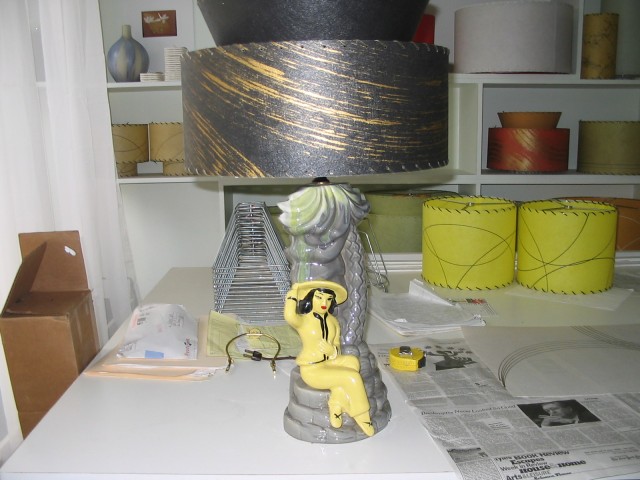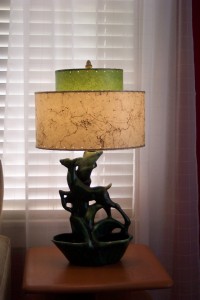
Selecting Shallow Drum Lampshades (table lamp)
Meteor Lights offers endless combinations of lampshade styles, sizes, fabric colors, patterns, and whipstitched lanyard trim.
We stock a small but reasonably representative assortment of ready-to-ship sample lamp and pendant shades available for sale, but in most cases, we will have to make your shade or pendant lamp to custom order.
Choosing Correct Lampshade Shape and Size
Selecting the correct tiered or drum shade size and style for your vintage or modern lamp can be tricky at first. In our *ahem* many years of experience with lamps and shades, we’ve found the following suggestions to be helpful.

First, we recommend selecting an appropriate lampshade style (i.e.shape). Some examples are the drum, two-tier, reverse two-tier, or atomic shade styles. Often, more than one type of shade will work, and it is simply a judgment call on your part: what looks good to your eye? At other times, only one style will work, and this will probably be obvious. With certain lamp styles, our retro/modern drum shades may not be the best match for your lamp, and a another style might work better. Ideally, the lampshade should help balance the volume of the lamp base. This is why a low-profile drum shade works well on slender 1950s/mid-century lamps, and sometimes not as well on bulkier 1960s- and 1970s-era models.
As a general rule of thumb on a table lamp, the bottom of the lampshade should be approximate to the height of the lamp base (not including the socket and harp assembly). For example, a 15″ tall lamp base (excluding the neck, harp, socket, and finial) usually needs a shade with a 15″ bottom ring (+/- 1″ or 1.5″). However, this guideline does not apply to 3-tier and reverse 2-tier shades, where the bottom tier is smaller than the top or middle tier. In these cases, the larger tier should be approximate to the height of the base.
If you have space limitations, you may have to consider a smaller diameter shade. However, the shade should never be closer to the bulb than the wattage permits. More information on allowable wattage and diameter can be found on our FAQ page.
Often, the original lamp harp (the hoop-shaped piece that supports the lampshade) has been replaced with an over-sized harp in order to accommodate a deep drum lampshade. The harp is a two-piece assembly consisting of the harp saddle (the inverted u-shaped bracket immediately below the lamp socket) and the harp itself, which usually snaps into the saddle. In most cases, a smaller harp can be swapped in.
A small percentage of harps use a heavy-duty harp saddle that requires a heavy-duty (heavier gauge) harp. If you have difficulty locating the proper height heavy-duty harp, let us know, and we can usually provide you with the correct one. Very rarely, and only on older lamps, a harp will be crimped onto the saddle, making for a one-piece harp. In these rare cases, the harp assembly may need to replaced, which typically involves rewiring the lamp.
.


Set the base at the approximate height of the surface that the lamp will be used on. Viewed straight-on at eye level, the lampshade should cover the lamp hardware (i.e. at least to the bottom of the harp). A shade hanging too low (too much of the base is covered) needs either a larger harp or the height of the shade shortened.
A shade fitting too high (too much of the hardware is visible) needs either a smaller harp, or a taller shade. There are some limitations to how tall our retro-styled shades can be made; in some cases, your lamp will need the deep drum style of the mid 60s to 70s (i.e. at least 15″ on the bottom, and at least 15″ tall). We fabricate this style as a special order, and they do cost a bit more to fabricate and ship than our regular lampshades
Most table lamps have a transitional neck immediately below the harp. This piece can range in height from 1/2″ to 2″ or more. They are often made from brass or wood. The purpose of this piece is to enable the lampshade to cover up the lamp hardware, but not impinge on the base itself. Generally, the bottom of the shade is about level with the mid-range of the neck when viewed dead-on. The neck enables a little fudging when fitting a shade. On lamps without necks (this includes most homemade lamps, and “craft” lamps), a compromise must be made as to whether to hide the hardware and cover the top of the base, or to reveal the top of the base and expose the bottom of the hardware.
The location of the lamp e.g. (low coffee table, medium end table, high bureau) will have bearing on what height shade works best. For example, reverse 2-tier lampshades (smaller diameter on the bottom) work well with lamps eye level and higher (the smaller tier helps hide the hardware, and reduces bulb glare). Regular 2-tiers work well at eye level and lower (the larger tier reveals more of the top end of the base).
If you are unsure what size best balances with your base, you might want to try making mock-ups from cardboard (e.g. side of a box) to simulate the size of the shade. For example, a 15″ diameter drum by 9″ tall shade can be reasonably approximated in two dimensions (flattened perspective) by holding over the lamp a rectangular piece of cardboard cut to 15″ x 9″. This technique seems to work better as you stand further back from the lamp. This is only an approximation, and because of the flattened perspective, the mock-up will look smaller than the corresponding shade.

Fitting Shades to Floor Lamps

Choosing the right size and style shade for your floor lamp is easier than with a table lamp. Each table lamp style has a unique shape and volume, and the shade should be designed with these parameters in mind. Floor lamps have a round or square base at the bottom, but most of the height of the lamp consists of a plain or fluted pole. A thin pole presents a simple and neutral shape and volume configuration to work with.
Generally, XL (18″ diameter) shades work best with most floor lamps. In some cases, a 21″ diameter XXL shade may work (e.g. in a cavernous room or on a huge floor lamp), and in many cases, a large (15″ diameter) size shade is sufficient. In a few cases, medium or small (13″ or 10″ diameter) shades might even work, especially in cramped spaces, such as tight corners, or on short “mini” floor lamps.
To maintain proportionality, smaller diameter lampshades on a floor lamp need to be taller. There is no one rule of thumb, but once you’re below 13″ diameter, the shade height should be at least a few inches taller than the diameter (which may require a shade riser or taller harp to get the bottom of the shade to sit at the right height). Also, keep in mind that narrower shades require lower wattages, so unless you have an over-riding reason to use a tube-style shade, it is usually better to go with a larger size drum or tier style.
With a table lamp, your options are somewhat limited. You can’t just choose the shade size and style you like — you want to try to make sure the combination works with the table lamp shape and volume. Floor lamps are more forgiving, and the shade you like will usually work on most floor lamps.
As with a table lamp, you want to make sure the shade covers the harp and socket hardware. How much lower than that your want the shade to sit is often just a matter of what looks good to your eye. Sometimes there is a decorative neck or transition piece below the socket that you don’t want the shade to cover. Most floor lamps have adjustable lamp harps and saddles, so it’s usually a simple matter to adjust the height of the harp to get the shade to sit properly.

There a few other considerations on floor lamps with cluster bodies and torchiere bowls (inverted glass diffusers on which the shade sits, in place of a lamp harps). First, you want to be sure the narrowest diameter of the shade clears the cluster body. Low wattage (25W or 40W) candle or torpedo bulbs are usually used in floor lamp cluster bodies, so the diameter only needs a few inches clearance. This is really only an issue with three-tier and reverse two-tier styles. It’s the narrowest diameter of the bottom tier that has to be considered. OEM shades with torchiere bowls had “reflector bend” top rings, where the the bend in the wire helped center the shade on the bowl. We have a better solution: shade clips, that snap on over the lampshade ring spider wire, and slide up to the rolled edge on the bowl lip, keeping the shade firmly in place.
Lampshade Colors
Consider the function of the lamp when choosing a color. A work or reading lamp should generally be warm or neutral. Deep blue, red, or purple may be hard to read by. With an accent lamp, however, choose any color you like to fit the room and ambience you wish to create. Sometimes a shade and lamp base look great when they are similar colors; at other times, this effect can overwhelm the base. While we can match colors to your couch, wall, etc., be careful when doing this, as the effect can be contrived if taken too far. In case of doubt, warm neutral colors are almost always a good choice.
2 responses to “mid-century lampshade & light fixture tips”
Hello…I just purchased a pair of 1950’s table lamps…and I need a pair of shades for them. They are 21″ from the bottom of the lamp to the bottom of the socket. Can I send you photos for your suggestions?
Yes, please send pics to our email and we’ll get back to you.
Please use the comments form for, well, comments, as well as general questions, suggestions, reminiscences, recipes, and camping tips. Please email us directly ( store(AT)meteorlights.com ) if you have specific questions.

Leave a Reply